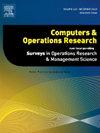Estimating production technologies using multi-output adaptive constrained enveloping splines
IF 4.3
2区 工程技术
Q2 COMPUTER SCIENCE, INTERDISCIPLINARY APPLICATIONS
引用次数: 0
Abstract
Data Envelopment Analysis (DEA) is a widely used method for evaluating the relative efficiency of decision-making units, but it often yields overly optimistic efficiency estimates, particularly with small sample sizes. To overcome this limitation, we introduce Adaptive Constrained Enveloping Splines (ACES), a non-parametric technique based on regression splines to accommodate multi-output, multi-input production contexts. ACES employs a three-stage estimation process. In the first stage, optimal output levels are estimated while incorporating essential envelope constraints, with optional monotonicity and/or concavity adjustments as needed. In the second stage, a refinement phase is carried out in which some of the estimates made are replaced by the observed values. Finally, a DEA-type technology is constructed using a new virtual data sample, ensuring adherence to usual shape constraints. Although ACES entails a higher computational cost, it achieves substantially lower mean squared error and bias than alternative methods of the literature across a wide range of simulated scenarios. This improvement is particularly pronounced in settings with complex production structures or heterogeneous returns to scale. This performance is consistent across both noise-free and noisy data environments, underscoring the method’s robustness and accuracy.
利用多输出自适应约束包络样条估算生产工艺
数据包络分析(DEA)是一种广泛使用的评估决策单位相对效率的方法,但它经常产生过于乐观的效率估计,特别是在小样本量的情况下。为了克服这一限制,我们引入了自适应约束包络样条(ACES),这是一种基于回归样条的非参数技术,可适应多输出、多输入的生产环境。ACES采用了三个阶段的评估过程。在第一阶段,估计最优输出水平,同时结合基本的包络约束,并根据需要进行可选的单调性和/或凹凸性调整。在第二阶段,进行细化阶段,其中一些估计被观测值所取代。最后,利用新的虚拟数据样本构造了一种dea类型的技术,以确保遵守通常的形状约束。尽管ACES需要更高的计算成本,但在广泛的模拟场景中,它比文献中的其他方法实现了更低的均方误差和偏差。这种改善在生产结构复杂或规模回报不均匀的情况下尤为明显。这种性能在无噪声和有噪声的数据环境中都是一致的,强调了该方法的鲁棒性和准确性。
本文章由计算机程序翻译,如有差异,请以英文原文为准。
求助全文
约1分钟内获得全文
求助全文
来源期刊

Computers & Operations Research
工程技术-工程:工业
CiteScore
8.60
自引率
8.70%
发文量
292
审稿时长
8.5 months
期刊介绍:
Operations research and computers meet in a large number of scientific fields, many of which are of vital current concern to our troubled society. These include, among others, ecology, transportation, safety, reliability, urban planning, economics, inventory control, investment strategy and logistics (including reverse logistics). Computers & Operations Research provides an international forum for the application of computers and operations research techniques to problems in these and related fields.
 求助内容:
求助内容: 应助结果提醒方式:
应助结果提醒方式:


